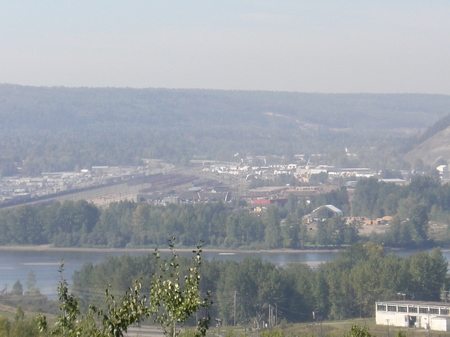North Nechako and Heritage Residents Submit Recommendations for Task Force on Air Quality.
By 250 News

Prince George during an air quality advisory in the summer of ’07 ( photo Opinion250 archive)
Prince George, B.C. - The North Nechako and Heritage Residents Association for Clean Air has made some recommendations to the Mayor’s Task Force on Air Quality. Making reference to many of the recommendations presented by the Mayor’s Task Force, the group has expaned on some of the thoughts presented in the preliminary report. ( view the preliminary report and its recommendations here).
The group continues to ask for changes to the developmental process in order to manage land use and pollution. The group points to the concept introduced by Councilor Deborah Munoz at the last Council meeting. She presented a development check list that focuses on the environmental or air quality impacts of any proposed project.
The North Nechako and Heritage residents point to that check list as their first recommendation on the matters as they relate to land use:
1.Create a recommendation around the new development approval process (to manage land use and pollution). The concept introduced by councillor Deborah Munoz at city council on November 5th, is a template to follow. (See Councillor Pushes for Air Quality Questions for Developments )
2.Fix old zoning issues in The City of Prince George. There remains a significant risk to further incompatible development on the Otway Bench and elsewhere in the city.
3.The city should do land swaps to relocate heavy industrial zoning to appropriate areas where there are light industrial and commercial buffers between heavy industry and residential zoning. This process must be initiated by The City of Prince George. (see Official Community Plan review ) If asphalt plants want to work under lower standards, then moving to a less compromised air shed could be an alternative.
Industrial Emissions and Monitoring:
1.The City of Prince George seek declaration as a designated sensitive airshed. The MOE could then require (through permits) that asphalt plants and gravel pit operations within the bowl comply with the best of GVRD emission standards. Why do Vancouver residents enjoy a superior set of regulations that have particulate emission limits that are half of what is allowed in our regulations (40mg/m3 GVRD...ours is 90 mg/m3).
2.We would like to see particulate (dustfall) measured at every industrial site in the city. Present regulations only measure the stack emissions and not the emissions from the screen deck and silos, and from gravel pit operations.
3.Asphalt regulation should also measure opacity and ambient air particulate.
4.Recommend that Colin Kinsley and the City Council of Prince George request that the provincial government update the asphalt regulations to match those of the best in the GVRD.
5. Recommend that the city continue to advocate for GVRD emission standards until they are put in place.
6.Recommend that Prince George be declared a sensitive airshed and that all industrial and municipal stacks be monitored and reported either continuously or on a frequent and random basis. Monitoring equipment can be placed on almost any stack.
7. A “tonnes per day” report for stacks in the sensitive airshed should be compiled by the Ministry of Environment. Some dispersed sources need to be monitored and studied for solutions but corrective action on stack emissions should be immediate.
Regulatory Tools:
1. The City of Prince George has a large responsibility for creating the pollution problem in North Nechako and should be obligated to correct it.
2.The City should require the best of the GVRD emission standards in its own asphalt contracts to lead the way to change in that sector. Preference in awarding city contracts should be given to plants operating in conformance with these better standards.
3.Enforcement of city by-laws is ineffective and needs to be fixed. When a resident phones city hall with a legitimate complaint they do not want to hear “that’s not my job” on the other end of the phone.
4.Restructure by-law enforcement so that it works and is easily accessed by the public.
Governance:
1.The Air Quality Coordinator job is broadly supported, but this person needs to be an advocate for clean air, not just a process support person for the plethora of committees which the job title implies. Perhaps the process needs an executive director who’s job is to work with all concerned to forward AQ improvement initiatives. It can be housed in the MOE, but jointly funded.
2.The coordinator should NOT be a city employee. The Ministry of Environment, in our experience, is much more effective at identifying problems and enforcing non compliance.
3.With this coordinator there should be one air quality complaint line to cover all pollution issues jointly for the MOE and for the city ( the city controls dust issues on streets, parking lots and in gravel pits).
4.This coordinator in conjunction with our Mayor and council must declare Prince George a sensitive air shed and begin a pilot pollution prevention program to lead the way for other similar cities in British Columbia.
The Mayor’s Task Force on air quality will present its final report to Council before the end of the year.
Previous Story - Next Story
Return to Home









How many new houses were built in the North Nechako and Heritage area in the last 12 months?